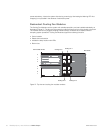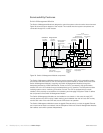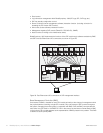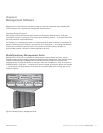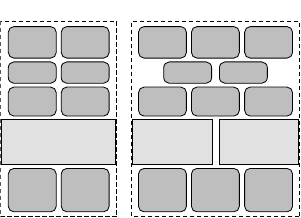
www.hitachi.com BladeSymphony 1000 Architecture White Paper 49
And the host intervention code is tuned for the latest Itanium hardware features, minimizing the
performance impact to guests.
Virtage offers two modes in which processor resources can be distributed among the different logical
partitions: dedicated mode and shared mode, as illustrated in Figure 31.
Figure 31. Share or isolate CPU and I/O resources to any partition in the same environment
Dedicated Mode
Individual processor cores can be assigned to a specific logical partition. Dedicating the core to an
LPAR helps ensure that no other partition can take CPU resources away from the assigned partition.
This method is highly recommended for environments that require CPU processing exclusivity, such as
databases or real time applications.
Shared Mode
A single processor core or groups of cores can be assigned to multiple logical partitions, which in turn
can share the assigned processing resources. This allows multiple partitions to share one or multiple
CPU cores to increase utilization. Virtage can also carve up a single processor core into logical
partitions for workloads that are smaller than one core.
Each partition is assigned a service rate of the processor. Another advantage is the ability to
dynamically change the services ratio for any given partition. The system monitors the activity of a
partition, and if one partition is idle while the other is using 100 percent of its share, the system
temporarily increases the service rate until CPU resources are required by the other partition.
High I/O Performance
When deployed on Itanium processor-based server blades, Virtage employs direct execution, as is
used in the mainframe world, leveraging Virtage technology embedded in the Hitachi Node Controller.
The Virtage I/O hardware assist feature passes data through the guest I/O requests with minimum
modification, thus does not add an extra layer for guest I/O accesses. Users can use standard I/O
device drivers as they are, so they can take advantage of the latest functionality with less overhead.
The hardware assist feature simply modifies the memory addresses for the I/O requests.
Also, because BladeSymphony 1000 can be configured with physical PCI slots, I/O can be assigned by
the slot to any given partition. Therefore, any partition can be assigned any amount of slots and each
partition can be mounted with any standard PCI interface cards. Since the PCI slots are assigned to the
partition, each environment can support a unique PCI interface card.
Dedicated Mode Shared Mode
Partition 1
Partition 2 Partition 3
CPU
NIC
PCI
Memory
CPU
NIC
PCI
PCI PCI PCI
Memory
CPU
NIC
Memory
CPU CPU
NIC
NIC
Memory




